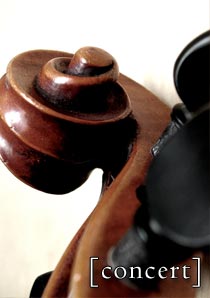Artemis
| Year Composed: | 2009 |
| Instrumentation: | 2.2.2.2/2.2.0.0/timp+1 perc/hp/strings |
| Duration | 10 minutes |
Audio Excerpts (MP3)
- I. The Hunt (live)
- II. In the Pale Moonlight
- III. Dance of Artemis (live)
Program Notes
"Over the shadowy hills and wind-blown peaks of the mountains, she leads the hunt, delighting in drawing her bow, all of gold, and shooting her deadly shafts. The hilltops are shaken by terror, and the dark of the woods resounds with the terrified screaming of beasts; the earth and the fish-laden ocean tremble in fear at her coming. She roves over all, fearless-hearted, slaying all races of creatures. But when the huntress, delighter in arrows, has sated her longing, rejoicing in heart, she loosens the string of her well-curved bow, and returns to the mighty palace of Phoebus Apollo, her brother, in the fertile country of Delphi, to join with the Muses and Graces in treading the maze of the dance..."
Such is Homer's description of Artemis, daughter of Zeus, the virgin goddess of wildlife. A deadly huntress who killed without mercy, striking down any who transgressed her law with her gold-tipped arrows, she was also a lover of animals, of music and dance, and a symbol of fertility. In Greek mythology, she was the quintessential 'untamed' woman: beautiful, alluring, but vengeful and unspeakably dangerous. Although men desired her, she kept her chastity, as anyone foolish enough to admire her too closely usually met with an untimely end.
Artemis is a musical portrait of the Greek goddess in the manner of Gustav Holst's symphonic suite The Planets, whose seven movements are based on the Greek deities' Roman counterparts. The movement "Mars, the Bringer of War" (Ares to the Greeks) was particularly influential in the conception of this piece. There are two places in Artemis which overtly reference the martial rhythms and harmonic progressions of "Mars." At the same time, I sought to emphasize qualities which I thought would befit a more feminine warrior: speed and swiftness, lightness, agility. The 'masculine' lower brass contingent is here replaced by a small but fierce percussion battery.
Artemis is divided into three sections which follow one another without pause. The first, "The Hunt," is a tempestuous depiction of the goddess as she rains destruction upon her victims. Amidst the frenzy of percussion which launches the work, the horns sound a war-call in their lowest registers, signaling the goddess's approach. The closing fugue is an ode to the goddess's classical qualities -- beauty, sophistication, and deadly grace.
The title of the second section ("In the Pale Moonlight") refers to Artemis's designation as the Goddess of the Moon (her twin brother, Apollo, is sometimes referred to as the Sun God.) Their mother was persecuted by Zeus's wife, Hera, who forbade her to give birth on any land that saw the light of day. So Apollo and Artemis were born on two floating islands, which at times rose above the surface of the sea, and at times dipped beneath it. The music is a meditation on the goddess's place of origin and her sacred woodlands, where only the 'pure of heart' may enter.
Although the title of the third section, "Dance of Artemis," is suggestive of the goddess’s lighter, more life-affirming qualities, it is in truth nearly as aggressive as the hunt itself. Only by the end do we realize that the violence has been transfigured into a kind of war dance, both celebratory and a cruel. Swirling swings give way to a majestic statement of the Artemis Theme, at last revealed in its fullest form.
This theme has its own origins in a short chamber piece I composed earlier this year, based on the Aboriginal legend "The White Horse," about an Assiniboine bride caught between a deadly rivalry between two clans. It is perhaps my fascination with myths, particularly in the way they can reveal deeper truths about human nature, compelled me to embrace these two very different, almost opposite subjects -- one victim, one avenging angel -- with a similar musical perspective.
Sheet Music
Performances
- September 24, 2009 - Toronto Philharmonia, conducted by Kerry Stratton. George Weston Recital Hall, Toronto Centre for the Arts, Toronto
- November 24, 2009 (recording) - Sneak Peek Orchestra, conducted by Victor Cheng. Calvin Presbyterian Church, Toronto
- November 6, 2010 - Sneak Peek Orchestra, conducted by Victor Cheng. Calvin Presbyterian Church, Toronto
- May 5, 2013 - Kindred Spirits Orchestra, conducted by Kristian Alexander. Markham Theatre, Markham
- May 15, 2013 - South Bohemian Chamber Philharmonic, conducted by Debashish Chaudhuri. Otakar Jeremiáš, ?eské Bud?jovice, Czech Republic.
- September 19, 2013 - Niagara Symphony Orchestra, conducted by Bradley Thachuk. Brock Centre for the Arts, St. Catherines.
- November 18, 2017 - Indianapolis Chamber Orchestra, conducted by Bradley Thachuk. Howard L. Schrott Center for the Arts, Indianapolis; Indiana, USA.
- October 6, 2018 - Oregon Mozart Players, conducted by Kelly Kuo. Beall Concert Hall, Eugene; Oregon, USA.
- October 21, 2018 - Orchestra Toronto, conducted by Michael Newnham. George Weston Recital Hall, Toronto Centre for the Arts; Toronto

